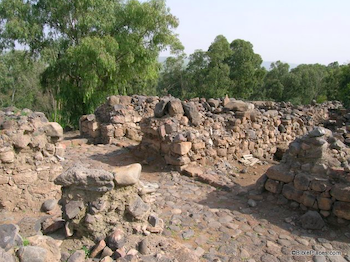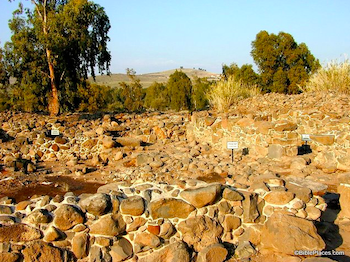By Elizabeth McNamer
Assistant Professor of Religious Studies
Department of Philosophy and Religion
Rocky Mountain College
Billings, Montana
August 2010
Stories of men abound in the Bible, laying bare for us what men did and calling for our applause at their heroism. Archaeology at Bethsaida too tells us that they built walls and roads, fought wars against the Assyrians and maybe even the Romans, went fishing, congregated at the city gates to conduct business and religious rites, and drank beer and wine. But the Bible tells us little about the contribution of women. It touches lightly on the patriarch’s wives and a few others of exceptional strength and ingenuity: Hanna, Deborah, Miriam, Esther, Abigail, Hulda, Judith. We are conscious when we read of these women; they were operating outside their usual domain, albeit they were using the skills learned at the hearth.
Women clearly had a domain. Households of women are referred to several times. The kitchen (bet’em) was their specific place of work. Several kitchens have been found at Bethsaida But what did they do there?
The book of Proverbs (chapter 31) tells that women were engaged from morning to night and indeed well into the night in a myriad of tasks. They carded wool, made linen, prepared food for her family, worked by oil lamps, made bedding, bought property, planted a vineyard, taught their children, helped the poor, were charming and beautiful and wise and made sure that their husbands were respected in the city gates. Surely the writer is exaggerating. Did they really do all this?
“Yes,” we reply from Bethsaida. “We have found the evidence.”
Most of the artifacts found at Bethsaida are in the domain of women: loom weights, ovens, cooking pots, jugs, juglets, grinders, flourmills, fish plates, olive bowls, pruning hooks, oil lamps, water jugs, jewels, wine jars (and cellars), needles, ungent jars, eating utensils.

Bibleplaces.com
Clothes were made of linen and wool. Making wool was a time-consuming task. It involved sheering the sheep, sorting and grading, spinning the yarn, and dying the wool, setting up the loom to make the fabric and then making it into clothing. Spinning was mandated by the Talmud (even rich women were required to spin). So many linen spores have been found at Bethsaida that we think there may have been a linen factory there. (It was required for sailing boats and for shrouds for the dead among other things). To clothe a family of six would have required about three hours a day of labor (and taking the Sabbath off). If she produced more than her family required, there were local markets and fairs at which the surplus could be sold.
Feeding was a woman’s prime obligation. Bread was the staple, and this was the most time-consuming of household activities. The grain had to be harvested and ground. The large grinder found in a fisheman’s house in Bethsaida required two women to operate it. About ten pounds of flour could be produced in one hour, although on a small grinder (one woman operated), only two pounds could be ground. Leavening was required to make the dough rise. (It could take three weeks for piece of dough to naturally develop yeast). Then there was the actual mixing, rising, and baking in a hot oven (which had to be kept going all night). The time required was three hours a day.
Dozens of oil lamps have been found at Bathsaida. Lamps were among the most essential household items. Custom required lamps at every occasion: birth, celebrations, wedding, and funerals. Lamps should not go out. The small oil lamps contained enough oil to burn for twelve hours. Oil had to be kept on hand. Who produced the oil? Women, of course, crushing the olives to extract the fuel by trampling on it. Oil was used for purification rites and cosmetics as well as for cooking.
Sheep and goats were kept in a courtyard adjacent to the house. They had to be milked on a regular basis. Cheese was made from the goat’s milk. A wide variety of foods are mentioned in the Bible: vegetables, beans, lentils, grains, herbs, nuts, figs, pomegranates, olives, grapes, dates, honey and fish. (Very little meat was eaten). She bought her fish directly off the fishing boats. There were stringent laws regarding fish, the main source of protein. Bethsaida has unearthed several plates especially designed for fish. And there are cooking pots galore.
Women brought water from the well. Numerous water containers have been located. These were carried on the top of the head. (This resulted in excellent posture!)
Her regular tasks would have taken eleven to twelve hours of each day. The Talmud required women to teach their children and to be learned in the law.
Then there were the seasonal tasks. Women were involved in economics. Coins have been found in every kitchen. She planted vineyards. She made wine. Yes, we have found the grape knives in her kitchen. This process took over forty days. Two wine cellars have been found proximate to the kitchen at Bethsaida . Brewing beer was also a woman’s task. (One scholar has surmised that by brewing of the beer, women maintained power and status in macho male dominated societies!) Bethsaida has produced a proliferation of barley at both the Iron Age and Roman areas.

Bibleplaces.com
Women married at an early age (when puberty began) and their years were spent producing one child after another. About one-third of women died in childbirth (despite the Pharaoh saying that Hebrew women gave birth easily.) While we have yet to find a birthing stone, we have found flint knives that may have been used for circumcision. A great number of babies also died in the first year. (This held true until relatively modern times).
Women cared about their appearance. We have found jewels and golden earrings and rings. They wanted to appear beautiful even when engaged.
Meanwhile what did he do? Well, he was respected in the city gates, sitting among the elders!
